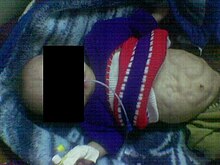Prune belly syndrome
| Prune belly syndrome | |
|---|---|
| Other names | Abdominal muscle deficiency syndrome, congenital absence of the abdominal muscles, Eagle-Barrett syndrome,[1] Obrinsky syndrome,[2] Fröhlich syndrome,[3] triad syndrome |
 | |
| Prune belly syndrome in an Egyptian child with Down syndrome. | |
| Specialty | Medical genetics |
Prune belly syndrome is a rare, genetic birth defect affecting about 1 in 40,000 births.[4] About 97% of those affected are male. Prune belly syndrome is a congenital disorder of the urinary system, characterized by a triad of symptoms. The syndrome is named for the mass of wrinkled skin that is often (but not always) present on the abdomen of those with the disorder.
Signs and symptoms
Prune-belly triad consists of signs such as: Cryptorchidism, abdominal wall defects and genitourinary defects:[5]
- A partial or complete lack of abdominal wall muscles. There may be wrinkly folds of skin covering the abdomen.
- Cryptorchidism (undescended testicles) in males
- Urinary tract abnormality such as unusually large ureters, distended bladder, accumulation and backflow of urine from the bladder to the ureters and the kidneys (vesicoureteral reflux)
Other signs include:
- Frequent urinary tract infections due to the inability to properly expel urine.
- Ventricular septal defect
- Malrotation of the gut
- Club foot
- Later in life, a common symptom is post-ejaculatory discomfort. Most likely a bladder spasm, it lasts about two hours.
- Musculoskeletal abnormalities include pectus excavatum, scoliosis, and congenital joint dislocations including the hip. Diagnosis of prune belly syndrome necessitates a thorough orthopaedic evaluation because of the high prevalence of associated musculoskeletal abnormalities.[6]
- Pulmonary hypoplasia, pneumonia, and atelectasis involving lung lobes[7]
Complications
Prune belly syndrome can result in distention and enlargement of internal organs such as the bladder and intestines. Surgery is often required but will not return the organs to a normal size. Bladder reductions have shown that the bladder will again stretch to its previous size due to lack of muscle. Complications may also arise from enlarged/malformed kidneys, which may result in kidney failure and the child's going on dialysis or requiring a kidney transplant. Many individuals with prune belly syndrome have good physical and mental health, despite all the concerns.[8] With proper treatment, however, a longer, healthier life is possible.[citation needed]
Diagnosis
Prune belly syndrome can be diagnosed via ultrasound while a child is still in-utero.[9] An abnormally large abdominal cavity resembling that of an obese person is the key indicator, as the abdomen swells with the pressure of accumulated urine.[citation needed]
In young children, frequent urinary tract infections often herald prune belly syndrome, as they are normally uncommon. If a problem is suspected, doctors can perform blood tests to check renal function. Another study that may suggest the syndrome is a voiding cystourethrogram.[citation needed]
PBS is far more common in males. Autosomal recessive inheritance has been suggested in some cases. A homozygous mutation in the muscarinic cholinergic receptor-3 gene (CHRM3) on chromosome 1q43 was reported in one family.[10]
Treatment
The type of treatment, like that of most disorders, depends on the severity of the symptoms. One option is to perform a vesicostomy, which allows the bladder to drain through a small hole in the abdomen, thus helping to prevent urinary tract infections. Similarly, consistent self-catheterization, often several times per day, can be an effective approach to preventing infections. A more drastic procedure is a surgical "remodeling" of the abdominal wall and urinary tract. Boys often need to undergo an orchiopexy to move the testes to their proper place in the scrotum.[citation needed]
References
- ^ Eagle JF, Barrett GS (1950). "Congenital deficiency of abdominal musculature with associated genitourinary abnormalities: A syndrome. Report of 9 cases". Pediatrics. 6 (5): 721–36. PMID 14797335.
- ^ Obrinsky W (1949). "Agenesis of abdominal muscles with associated malformation of the genitourinary tract; a clinical syndrome". Am J Dis Child. 77 (3): 362–73. doi:10.1001/archpedi.1949.02030040372008. PMID 18116668.
- ^ Frolich, F. Der Mangel der Muskeln, insbesondere der Seitenbauchmuskeln. Dissertation: Wurzburg 1839.
- ^ Baird PA, MacDonald EC (1981). "An epidemiologic study of congenital malformations of the anterior abdominal wall in more than half a million consecutive live births". Am. J. Hum. Genet. 33 (3): 470–8. PMC 1685049. PMID 6454342.
- ^ Bhat, Sriram M. (2016-06-30). SRB's Manual of Surgery. ISBN 9789351524168.
- ^ Brinker MR, Palutsis RS, Sarwark JF 1995. The orthopaedic manifestations of prune-belly (Eagle-Barrett) syndrome. J Bone Joint Surg Am. 77(2):251-7
- ^ Alford, Bennett A.; Peoples, W. M.; Resnick, Jack S.; L'Heureux, Philippe R. (November 1978). "Pulmonary Complications Associated with the Prune-Belly Syndrome". Radiology. 129 (2): 401–407. doi:10.1148/129.2.401. ISSN 0033-8419.
- ^ "Prune belly syndrome | Genetic and Rare Diseases Information Center (GARD) – an NCATS Program". rarediseases.info.nih.gov.
- ^ synd/1499 at Who Named It?
- ^ "OMIM Entry - # 100100 - PRUNE BELLY SYNDROME; PBS". www.omim.org.
